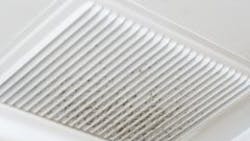In the United States alone, more than 1.5 billion pounds of PCBs (polychlorinated biphenyls) were produced for use in building components such as electrical equipment, hydraulics, paints, plastics and caulks between 1925 and 1978, according to Environmental Health News. More than one-half of U.S. educational buildings were constructed between 1946 and 1969, and nearly 40 percent were built during or after the 1970s, according to the Department of Education. As a result, the potential for indoor air contamination in schools is significant as most were built during the peak application of PCB-laden building materials.
The use of PCBs in building materials has long been known but the extent of the use and the potential impacts to building occupants and the environment has become a focus in recent years. With the publication of guidance documents, the EPA has raised awareness of the issue with the general public.
Schools are faced with limited alternatives when handling PCB-containing building materials, but there are several acceptable compliance options including:
-No Action. A school may determine that ¡°No Action¡± is the best option to pursue at a given time because of budget constraints or the desire to see policy and work practices become better defined before taking action. Current EPA guidance suggests testing should be performed, but there is no legal requirement to do so. Thus, unless other drivers lead to a need to sample, the building owner is not required to perform any actions.
-Best Practices. The EPA recommends a series of ¡°best practices¡± to minimize potential exposures to airborne PCBs or dust contaminated with PCBs. Schools may implement these practices without performing any sampling that might trigger other regulatory requirements. These practices include improved ventilation to reduce PCB concentrations in indoor air and improved housekeeping procedures to reduce dust levels.
Buildings with central air systems should take measures to ensure that the ventilation is functioning properly and that sufficient maintenance is being performed. For buildings without ventilation systems, EPA recommends opening windows or installing fans. Improved housekeeping procedures should include wet mopping or vacuuming with high efficiency particulate air filters be used to prevent the spread of dust.
-Risk Evaluation Sampling. If requested by building occupants, a school may perform testing to evaluate PCB risks. EPA recommends air sampling as the first step in this process. Prior to performing any air sampling, the school should implement EPA recommended best practices that could potentially reduce PCB concentrations in indoor air. If results from air sampling indicate potential PCB contamination, a school may be required to perform additional sampling that could identify building materials classified as PCB Bulk Product Wastes.
An effective air sampling program should take into account the size of the building, building usage, and ventilation system operation (if applicable) in the selection of sampling locations and number of samples collected.
Coordinating analytical methods with an EPA regional PCB coordinator prior to performing indoor air sampling will help align expectations. Sampling programs should be designed to identify the potential highest level sources first and then move on to other potential sources once the higher level sources have been eliminated or remediated. If PCBs are identified in the air, the first potential source to examine is light fixture ballasts. Common to school settings, PCB ballasts that have failed or are leaking can contribute to PCB in air concentrations. If a light fixture ballast is leaking PCBs, federal law requires immediate removal and disposal of the ballast and any PCB-contaminated materials at an EPA-approved facility. An experienced contractor should be retained for this work due to hazards associated with PCBs.
Caulks and glazings, which are a potential source of PCBs, can be identified by performing building surveys similar to those for asbestos containing materials (i.e., sampling and laboratory analysis). Caulks and glazings with PCB concentrations ¡Ý50 mg/kg are classified as PCB Bulk Product Wastes. Any materials identified as PCB Bulk Product Wastes must be removed.
Note that numerous low-level PCB sources in the same room can produce indoor air concentrations that approach or exceed Public Health Levels for Schools. In these cases, the removal of the building materials is not required. However, the school may be required to address these materials to eliminate them as a source of indoor air contamination.
-Demolition and Renovation. EPA regulations require that wastes be properly characterized prior to disposal, including PCBs in wastes generated during demolition and renovation activities. To properly characterize wastes, limit PCB investigation to those materials that will be disposed of during a project. For example, a window renovation project will require characterization of only the caulks and glazings that will be removed from the window and disposed during the renovation.
Samples of caulks, glazings, and other potentially contaminated materials should be collected prior to performing demolition and renovation actions as these activities might dilute PCB concentrations. Those materials found to contain PCBs must be disposed of separately from clean materials. Federal regulations allow for the disposal of PCB Bulk Product Wastes in non-hazardous waste landfills. However, state permitted landfills typically do not allow for disposal of PCB-contaminated materials. Pre-planning is key to ensure disposal facility acceptance.
Taking guidance
Regulations covering PCB-contaminated building materials are long established but the EPA has only recently published guidelines for contaminated light fixtures and building caulks. These guidance documents are helpful and describe various options to help schools comply with federal regulations. However, schools should be aware of the ramifications of collecting data. Because the use of building materials contaminated with PCBs greater than 50 ppm is unauthorized any data collected about PCB levels can lead to costly remedial actions. Thus, it is important to have a complete understanding of the issue and to proceed in a prudent manner based upon the needs of your school.
Sullivan, LSP, CHMM is a project manager with TRC, a national engineering consulting and construction management firm serving the energy, environmental and infrastructure markets.
